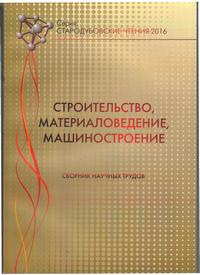Influence of austenite structure and its decay products on the quasi-brittle fracture of high strength plate for building construction
Keywords:
high-strength micro-alloyed steel, steel plate, microstructure, fractography, quasi-brittle fracture, toughness.Abstract
Influence of the grain size austenite on the formation of bainite, the fracture surface and toughness values of steel plate. Methodology. As a basic material for study was chosen is traditionally used in the construction of low-carbon low alloy steel 09G2S to compare close in chemical composition, but different strength and production technology, high-strength microalloyed steel 10G2FB. We studied: micro- and substructure bainite fractographic especially destruction of various geometrical parameters of packets of bainite and their influence on the toughness indices. Results. Conducted complex investigations possible to establish the relationship between the structure of austenite, the formation of bainite lath, fracture toughness, and surface of 09G2S 10G2FB steels. Originality. It is found that the reason for the decrease in toughness of the hot rolled plate and 09G2S 10G2FB steels is the formation of fractures in portions quasi-brittle cracking which are associated with an increase in bainite structure steel component, formed from relatively large (65 m) of austenite grains. Practical significance. The relationship of micro- and substructure - the cracking of the surface - toughness enable to adjust operating modes controlled rolling in the manufacture of steel 10G2FB to stabilize the mechanical properties and reduce the rejection toughness.
References
В. И. Большаков. Инновационная технология производства толстых листов – полигонизационная прокатка / В. И. Большаков, Г. Д. Сухомлин, Д. В. Лаухин та ін. // Строительство, материаловедение, машиностроение. – 2011. – Вып. 59. – С. 145–151.
Дислокационная структура и конструктивная прочность стали / Л. И. Тушинский // Пути повышения конструктивной прочности металлов и сплавов. – 1982. – С. 6–8.
П. Д. Одесский. Стали нового поколения для металлических конструкций / П. Д. Одесский, И. И. Ведяков, А. В. Рудченко // Металловедение и термическая обработка металлов. – 2002. – №2. – С. 30–41.
Recrystallization Controlled Rolling and Accelerated Cooling as the Optimum Processing Route for High Strength and Toughness in V-Ti-N Steels / S. Zajac, Т. Siwecki, В. Hutchinson, M. Attlegard // Met. Trans. – 1991. – 22A. – P. 1681–1693.
Properties of Large Diameter Line Pipe Steel Produced by Accelerated Cooling After Controlled Rolling / Tamehiro H. // Accelerated Cooling of Steel, 1986. – Warrendale, PA: TMS-AIME, 1986. – P. 401–413.
Hot Rolling as a High-Temperature Thermo-Mechanical Process / I. Kozasu // Microalloying '75, Union Carbide Corp., 1977. – New York, NY: Union Carbide Corp. , 1977. – P. 120–135.
Ferrite Formation from Thermomechanically Processed Austenite in HS LA Steels / A. J. DeArdo // HSLA Steels. –1985. – Р. 70–79.
Вплив параметрів структури на кінетику руйнування мікролегованих будівельних сталей: Дис. Канд.. техн. наук : 05.02.01. / Іванцов Сергій Вікторович – Дніпропетровськ, 2015. – 141 с.
Морфологія, тонка структура, властивості голчастого фериту при зміцнюванні будівельних сталей: Дис. канд. техн. наук : 05.02.01. / Куксенко В'ячеслав Іванович – Дніпропетровськ, 2010. – 133 с.
S. Lartigue. Stability of extrinsic grain boundary dislocations in relation with intergranular segregation and precipitation / S. Lartigue, L. Priester // Acta Metall. – 1983. – Vol. 31. – Р. 1809–1819.
Davenport A. T. The Recrystallization of Austenite During the Hot Rolling of a Nb-Bearing HSLA Steel / A. T. Davenport, R. E. Miner, R. A. Kot // The Hot Deformation of Austenite, 1976. – New York, TMS-AIME. – 1976. –P. 186–203.
Нотт Дж.Ф. Основы механики разрушения / Нотт Дж.Ф.; пер. с англ. Д.В. Лаптева. – М.: Металлургия, 1978. – 256 с.
Dube C. A. La formation de ferrite proeutectoide dans les aciers au carbone / C. A. Dube, H. I. Aaronson, R. F. Mehl // Rev. Met. – 1958. – Vol. 55. – Р. 201–210.
Испытания на ударный изгиб при пониженной, комнатной и повышенных температурах : ГОСТ 9454-78. –[Чинний від 1979-01-01]. – М. : Государственный комитет по стандартам СССР, 1978. – 11с. – (Національній стандарт України).
Практическая растровая электронная микроскопия / Дж. Гоулдстейна, Х. Яковица; пер. с англ. В. И. Петрова. – М. : Мир, 1978. – 656 с. REFERENCES
Downloads
Published
Issue
Section
License
Редакція Видання категорично засуджує прояви плагіату в статтях та вживає всіх можливих заходів для його недопущення. Плагіат розглядається як форма порушення авторських прав і наукової етики.
При виявлені у статті більш ніж 25% запозиченого тексту без відповідних посилань та використання лапок, стаття кваліфікується як така, що містить плагіат. У цьому випадку стаття більше не розглядається редакцією, а автор отримує перше попередження.
Автори, в статтях яких повторно виявлено плагіат, не зможуть публікуватися в усіх журналах Видавництва ДВНЗ «Придніпровська державна академія будівництва та архітектури».
Автори, які публікуються у цьому журналі, погоджуються з наступними умовами:
- Автори залишають за собою право на авторство своєї роботи та передають журналу право першої публікації цієї роботи на умовах ліцензії Creative Commons Attribution License, котра дозволяє іншим особам вільно розповсюджувати опубліковану роботу з обов'язковим посиланням на авторів оригінальної роботи та першу публікацію роботи у цьому журналі.
- Автори мають право укладати самостійні додаткові угоди щодо неексклюзивного розповсюдження роботи у тому вигляді, в якому вона була опублікована цим журналом (наприклад, розміщувати роботу в електронному сховищі установи або публікувати у складі монографії), за умови збереження посилання на першу публікацію роботи у цьому журналі.
- Політика журналу дозволяє і заохочує розміщення авторами в мережі Інтернет (наприклад, у сховищах установ або на особистих веб-сайтах) рукопису роботи, як до подання цього рукопису до редакції, так і під час його редакційного опрацювання, оскільки це сприяє виникненню продуктивної наукової дискусії та позитивно позначається на оперативності та динаміці цитування опублікованої роботи (див. The Effect of Open Access).

